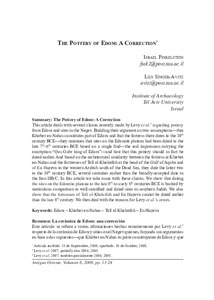Por favor, use este identificador para citar o enlazar este ítem:
https://repositorio.uca.edu.ar/handle/123456789/12023| Título: | The pottery of Edom : a correction La cerámica de Edom : una corrección |
Autor: | Finkelstein, Israel Singer-Avitz, Lily |
Palabras clave: | CERAMICA; ARQUEOLOGIA; HISTORIA ANTIGUA; Edom | Fecha de publicación: | 2008 | Editorial: | Pontificia Universidad Católica Argentina. Facultad de Ciencias Sociales. Departamento de Historia. Centro de Estudios de Historia del Antiguo Oriente | Cita: | Finkelstein, I., Singer-Avitz, L. The pottery of Edom : a correction [en línea]. Antiguo Oriente : Cuadernos del Centro de Estudios de Historia del Antiguo Oriente. 2008, 6. Disponible en: https://repositorio.uca.edu.ar/handle/123456789/12023 | Resumen: | Abstract: This article deals with several claims recently made by Levy et al.1 regarding pottery
from Edom and sites in the Negev. Building their argument on two assumptions—that
Khirbet en-Nahas constitutes part of Edom and that the fortress there dates to the 10th
century BCE—they maintain that sites on the Edomite plateau had been dated to the
late 7th–6th centuries BCE based on a single find—the seal impression carrying the
inscription “Qos Gabr king of Edom”—and hint that this pottery should in fact be
dated earlier. And based on the architectural similarity between the fortress at Khirbet
en-Nahas and the fortresses of Tell el-Kheleifeh at the head of the Gulf of Aqaba and
of En HaÐeva in the western Arabah south of the Dead Sea, they date the latter two
to the 10th century BCE, several centuries earlier than the broadly-accepted date in
the Iron IIB/C. In this article we take issue with these claims. We show that dating
the sites on the Edomite plateau to the late 8th-to-early 6th centuries BCE is backed by
meticulous comparison to well-stratified and dated sites in southern Judah. We also
show that the fortresses of Tell el-Kheleifeh and En HaÐeva cannot be dated earlier
than the late 8th century. We then deal with the reasons for Levy et al.’s errors. Resumen: Este artículo se refiere a varias afirmaciones hechas recientemente por Levy et al.2 respecto de la cerámica de Edom y sitios en el Negev quienes, forjando sus argumentos en base a dos supuestos—que Khirbet en-Nahas es parte constituyente de Edom y que su fortaleza data del siglo X a.C.— sostienen que los sitios en la meseta edomita fueron datados a finales del siglo VII y el VI a.C. en base a un único hallazgo—la impresión de sello con la inscripción “Qos Gabr rey de Edom”—e insinúan que esta cerámica debe ser, de hecho, datada más tempranamente. Y, basados en la similitud arquitectónica entre la fortaleza de Khirbet en-Nahas y las fortalezas de Tell el- Kheleifeh, en la entrada del Golfo de Aqaba, y de En HaÐeva, en el Arabá occidental al sur del Mar Muerto, datan las dos últimas en el siglo X a.C., varios siglos antes que la fecha comúnmente aceptada en el Hierro IIB/C. En este artículo nos oponemos a estas afirmaciones. Demostramos que la datación de los sitios en la meseta edomita entre finales del siglo VIII a.C. y principios del VI a.C. está basada en una meticulosa comparación con sitios bien estratificados y datados de Judá meridional. También demostramos que las fortalezas de Tell el-Kheleifeh y En HaÐeva no pueden ser datadas antes de finales del siglo VIII a.C. para luego tratar las razones de los errores de Levy et al. |
URI: | https://repositorio.uca.edu.ar/handle/123456789/12023 | ISSN: | 1667-9202 | Disciplina: | HISTORIA | Derechos: | Acceso abierto | Fuente: | Antiguo Oriente : Cuadernos del Centro de Estudios de Historia del Antiguo Oriente. 2008, 6 |
| Aparece en las colecciones: | AO - 2008 nro.6 |
Ficheros en este ítem:
| Fichero | Descripción | Tamaño | Formato | |
|---|---|---|---|---|
| pottery-edom-correction.pdf | 747,67 kB | Adobe PDF |  Visualizar/Abrir | |
| thumbnail.jpeg | 4,29 kB | JPEG |  Visualizar/Abrir |
Visualizaciones de página(s)
81
comprobado en 30-abr-2024
Descarga(s)
98
comprobado en 30-abr-2024
Google ScholarTM
Ver en Google Scholar
Este ítem está sujeto a una Licencia Creative Commons

